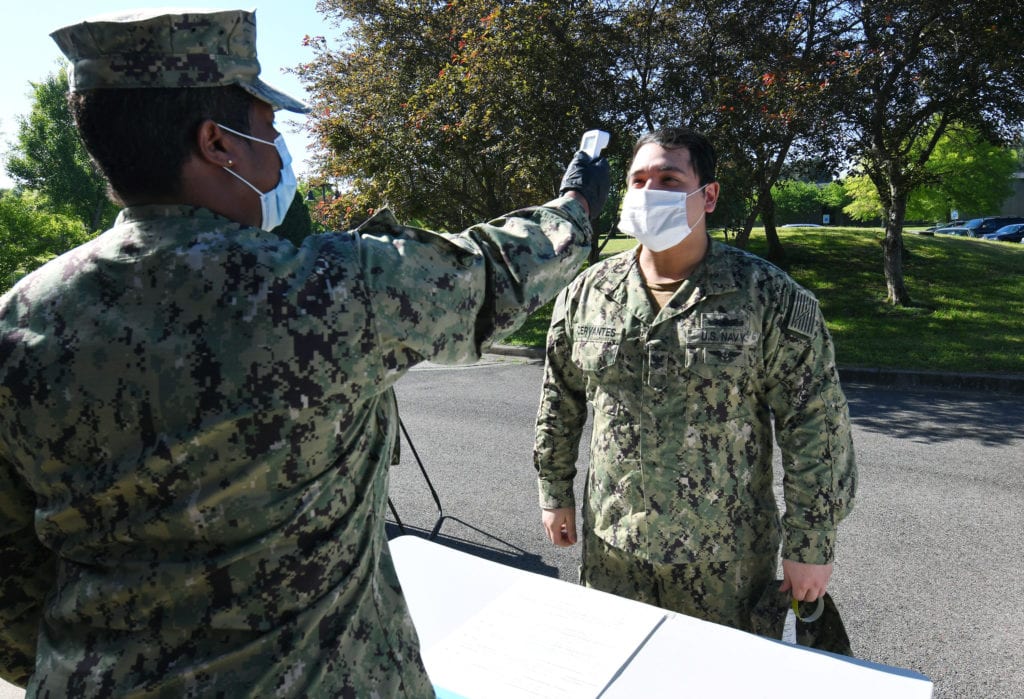
ARLINGTON, Va. — The Defense Department is rolling out new strategies for screening the force for the novel coronavirus to halt the spread, spot those needing medical treatment early and still enable the military to fulfill its mission, according to two top Pentagon officials.
“As we learn more about the virus, we will continue to evolve our approach,” Deputy Defense Secretary David Norquist told a Pentagon press briefing that was live-streamed on April 22.
He noted that hundreds of thousands of active-duty and civilian personnel are teleworking. However, for thousands more who cannot practice social distancing because they work in constrained spaces like new recruits in training or Sailors and Marines on ships or submarines at sea, there is a new general process to screen for COVID-19.
For those groups, the first of four containment steps is screening with the use of questionnaires and thermometers to identify at-risk individuals. Next comes 14 to 21 days of quarantine, depending on a unit’s risk tolerance, to identify those who are infected but not yet showing symptoms. A third step calls for conducting swab tests and temperature checks, prior to leaving quarantine, to identify those who have since become infected but remain asymptomatic. Finally, as a unit moves to its mission, Norquist said, “we’ll keep this group together but limit its outside interaction to prevent the introduction of infection.”
“As we learn more about the virus, we will continue to evolve our approach.”
Deputy Defense Secretary David Norquist
Procedures like face coverings, hand washing, maintaining clean workspaces and continued monitoring will all still apply as units move forward while therapeutic treatments and vaccines are still being developed, he said.
COVID-19 had infected more than 802,000 people in the U.S. and had killed 44,575 as of April 21, according to the U.S. Centers for Disease Control and Prevention. The Pentagon reported on April 22 that 3,578 cases of COVID-19 have been detected among U.S. military and civilian personnel, dependents and contractors; 25 have of those have died. The U.S. Navy continues to have the largest number of cases — 1,298 — compared to 841 for the Army, 337 for the Air Force, 259 for the Marine Corps and 713 for the National Guard.
Meanwhile, under the authorities granted by the Defense Production Act, the government is moving to increase production of critical N95 masks to 39 million in the next 90 days and to 141 million over the next six months, Norquist said. The Pentagon is working with vendors to increase swab production from three million a month to 20 million, also boosting production of personal protective equipment for medical personnel, reagents for testing kits and active pharmaceutical ingredients.
As testing supplies become more prevalent, testing will be conducted through a priority-based, tiered system recently approved by Defense Secretary Mark Esper, Air Force Gen. John Hyten, the vice chairman of the Joint Chiefs of Staff, told the press briefing.
Tier 1 will focus on critical national capabilities, like strategic nuclear deterrent units. Tier 2 will focus on engaged, fielded forces around the world. Tier 3 is for forward-deployed and redeploying forces and Tier 4 includes the remainder of the military.
Hyten was asked if he thought it was unwise for the Army Corps of Engineers to continue building treatment facilities, with hundreds of beds, in big city convention centers, even as existing ones are under-used.
“For gosh sakes, no! That’s what I want to see,” he said. If the beds are all filled, that means local hospitals have been overwhelmed. “You always want to have excess capacity, not too little capacity,” he added.
- Shall We Play a Game? Winning Isn’t the Point, Experts Say - April 5, 2023
- U.S. Goal: Maintaining Extended Presence in Arctic’s Harsh Environment - April 4, 2023
- Joint, Combined Exercise Shows Marine Littoral Regiment Idea is on ”Right Track’ - February 24, 2023






